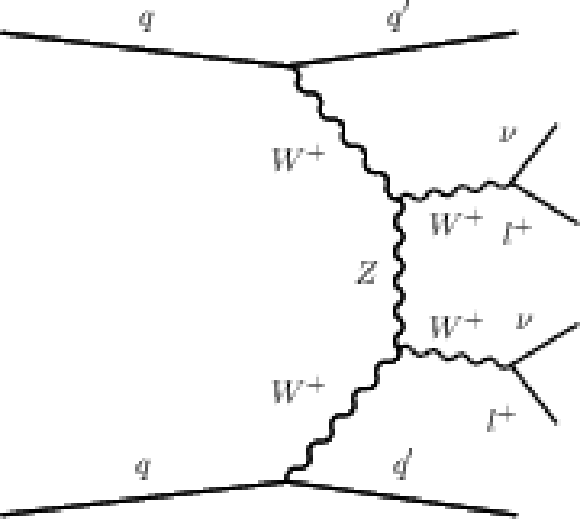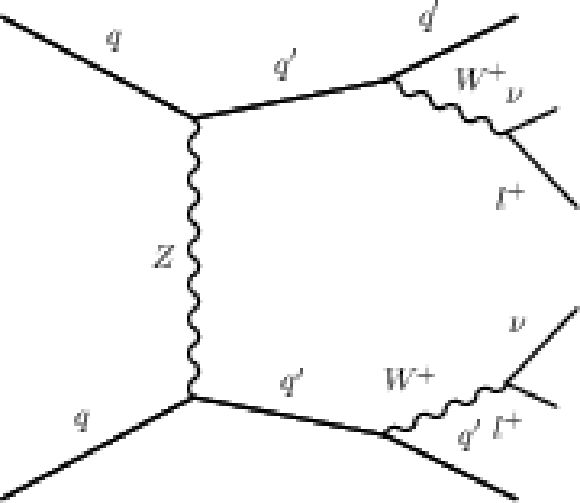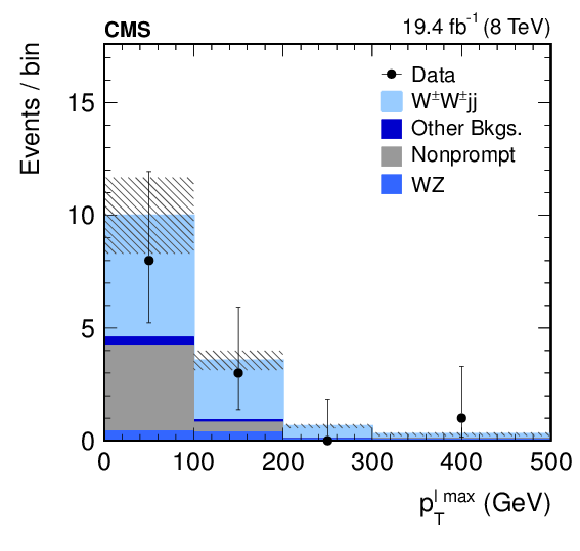

Compact Muon Solenoid
LHC, CERN
| CMS-SMP-13-015 ; CERN-PH-EP-2014-250 | ||
| Study of vector boson scattering and search for new physics in events with two same-sign leptons and two jets | ||
| CMS Collaboration | ||
| 23 October 2014 | ||
| Phys. Rev. Lett. 114 (2015) 051801 | ||
| Abstract: A measurement of vector-boson scattering in pp collisions at a center-of-mass energy of 8 TeV is presented. The data sample corresponds to an integrated luminosity of 19.4 fb$^{-1}$ collected with the CMS detector. Candidate events are selected with exactly two leptons, electrons or muons, with the same charge, two jets with large rapidity separation and mass, and moderate missing transverse energy. The signal region is dominated by electroweak same-sign W-boson pair production. The observation agrees with the standard model prediction. The observed significance is 2.0$\sigma$, where a significance of 3.1$\sigma$ is expected for the standard model. Cross section measurements of the $\mathrm{W}^{\pm}\mathrm{W}^{\pm}$ and $\mathrm{W}\mathrm{Z}$ processes in the fiducial region are reported. Bounds on the structure of quartic vector-boson interactions are given in the framework of dimension-eight effective field theory operators, as well as limits on the production of doubly-charged Higgs bosons. | ||
| Links: e-print arXiv:1410.6315 [hep-ex] (PDF) ; CDS record ; inSPIRE record ; Public twiki page ; CADI line (restricted) ; | ||
| Figures | |

png pdf |
Figure 1-a:
Representative Feynman diagrams for the electroweak and QCD induced same-sign $ {\mathrm {W}}$-boson pair production. |

png pdf |
Figure 1-b:
Representative Feynman diagrams for the electroweak and QCD induced same-sign $ {\mathrm {W}}$-boson pair production. |

png pdf |
Figure 1-c:
Representative Feynman diagrams for the electroweak and QCD induced same-sign $ {\mathrm {W}}$-boson pair production. |

png pdf |
Figure 1-d:
Representative Feynman diagrams for the electroweak and QCD induced same-sign $ {\mathrm {W}}$-boson pair production. |

png pdf |
Figure 2-a:
The distributions of $m_{jj}$ (left) and leading lepton $ {p_{\mathrm {T}}} $, $ { {p_{\mathrm {T}}} ^{\ell ,\text {max}}} $, in the signal region (right). The hatched bars include statistical and systematic uncertainties. The $ {\mathrm {W^+}} {\mathrm {W^+}}$ and $ {\mathrm {W^-}} {\mathrm {W^-}}$ candidates are combined in these distributions. The signal, $ {\mathrm {W}}^{\pm } {\mathrm {W}}^{\pm } jj$, includes EW and QCD processes and their interference. The histograms for other backgrounds include the contributions from wrong-sign events, DPS, and $ {\mathrm {V}} {\mathrm {V}} {\mathrm {V}} $ processes. |

png pdf |
Figure 2-b:
The distributions of $m_{jj}$ (left) and leading lepton $ {p_{\mathrm {T}}} $, $ { {p_{\mathrm {T}}} ^{\ell ,\text {max}}} $, in the signal region (right). The hatched bars include statistical and systematic uncertainties. The $ {\mathrm {W^+}} {\mathrm {W^+}}$ and $ {\mathrm {W^-}} {\mathrm {W^-}}$ candidates are combined in these distributions. The signal, $ {\mathrm {W}}^{\pm } {\mathrm {W}}^{\pm } jj$, includes EW and QCD processes and their interference. The histograms for other backgrounds include the contributions from wrong-sign events, DPS, and $ {\mathrm {V}} {\mathrm {V}} {\mathrm {V}} $ processes. |

png pdf |
Figure 3-a:
The $ {m_{\ell \ell }} $ distributions (left) after full selection with all SM backgrounds and $F_{T,0} / \Lambda ^4= -5.0$, 0 (SM), and $5.0 TeV ^{-4}$; the last bin includes overflow events. Observed and expected two-dimensional 95% CL limits (right) for $F_{S0}/ \Lambda ^4$ and $F_{S1}/ \Lambda ^4$. |

png pdf |
Figure 3-b:
The $ {m_{\ell \ell }} $ distributions (left) after full selection with all SM backgrounds and $F_{T,0} / \Lambda ^4= -5.0$, 0 (SM), and $5.0 TeV ^{-4}$; the last bin includes overflow events. Observed and expected two-dimensional 95% CL limits (right) for $F_{S0}/ \Lambda ^4$ and $F_{S1}/ \Lambda ^4$. |

png pdf |
Figure 4:
Expected and observed 95% CL upper limits on the cross section times branching fraction, $\sigma _{ {\mathrm {H}} ^{\pm \pm }}\mathcal {B}( {\mathrm {H}} ^{\pm \pm } \to {\mathrm {W}}^{\pm } {\mathrm {W}}^{\pm })$. Theoretical cross sections for three values of the vacuum expectation value (vev) are overlaid. |

|
Compact Muon Solenoid LHC, CERN |

|

|

|

|

|

|